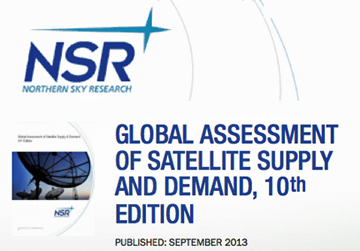
[SatNews] Concern has been raised throughout the satellite industry that the vast amount of new HTS supply coming to market, forecasted by NSR to increase by 1.5Tbps by 2022, will swamp existing C- and Ku-band transponder demand leading to a global drop in C/Ku pricing and negatively impacting revenues for legacy FSS services.
NSR does not deny, and in fact readily concurs, that some existing C- and Ku-band transponder demand for applications such as backhaul, trunking and VSAT networking will suffer in the coming years due to the arrival of new HTS systems. And there will as well be significant transponder price pressure for certain applications and/or satellites if some operators try to compete using classic C/Ku transponders on a pure price basis with the new HTS capacity.
This being said, NSR also argues based on data from its Global Assessment of Satellite Supply & Demand 10th Edition study that, net-net, the migration to HTS services is overall advantageous to the satellite industry in terms of real revenue gains in the coming ten years. The chart below attempts to make an “apples-to-apples” comparison of NSR’s forecasted net revenue gains for C- and Ku-band services – excluding the video distribution and DTH verticals that are the strongest natural fit for classic FSS capacity and benefit the least from the move to HTS – compared to the net wholesale HTS capacity revenue growth – excluding consumer broadband access services, which are effectively a new market segment.
It can be seen that while NSR does forecast a C-band transponder demand decline and revenue loss by 2022, the combined C- and Ku-band revenues for data-focused applications should continue to grow. This is an illustration of what NSR calls the “bifurcation” of the overall satellite industry as applications where issues of coverage and reliability trump pure price per bit continue to grow in transponder and revenue terms on C- and Ku-band, while services that are mainly cost per bit driven move to HTS capacity.
Even if NSR’s assessment of the overall HTS demand growth turns out to be overly optimistic or the negative impact on C and Ku-band demand is underestimated, a rough estimate shows that some combination of demand and pricing would need to drop by nearly 40% more beyond NSR’s current forecast in the coming ten years such that, on a net basis, revenue growth from HTS demand could not offset that lost in the C/Ku-band market. Today, NSR just does not see this as a likely proposition and feels that individuals raising concerns about the impact of new HTS supply are either failing to take the entire market picture into account or are greatly overestimating the real negative impact of the new HTS capacity; just as some in the past misjudged the negative impact of “new” Ku-band services on C-band demand or digital video on analog channels.
Bottom Line
Seen from certain perspectives, there is no doubt the growth of the HTS market in the coming years will have some negative impact on classic C- and Ku-band services. Yet, NSR forecasts that on an industry-wide basis the net gain in new HTS revenues for the applications that most directly compete with legacy C- and Ku-band will more than offset any revenue loss. In fact, NSR even forecasts a revenue increase in combined C/Ku-band data services as new markets and opportunities open up.
It is NSR’s belief that only the most pessimistic forecast of industry trends in the coming years would lead to a net loss in overall industry revenue growth for mainly data-type applications. While some individual players may feel the impact of HTS more acutely – both positively and negatively – the overall market prognosis remains good. NSR is fully confident of the satellite industry’s ability to adapt to, and fully profit from, the coming HTS revolution.

This executive summary of the NSR report was authored by Mr. French, who joined NSR in September 2003 and is the lead author for NSR’s annual studies Global Assessment of Satellite Demand and Broadband Satellite Markets.
For additional information regarding this report, access this direct infopage link.

